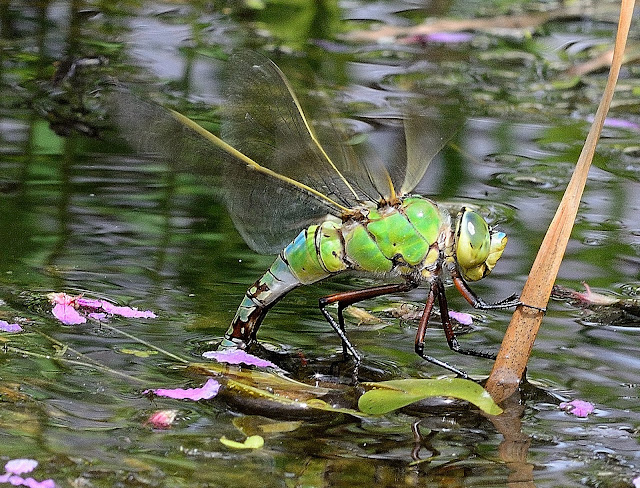A common chaser here is the Broad-bodied Chaser. The first adults are seen in April when as immature, the males have the same colouring as females. As they mature males take on a blue abdomen whereas the females remain yellowish-brown. However some very mature females may develop limited pruinosity.
The Four-spot Chaser has made a resurgence on the Isle of Wight recently. Once mainly found close to Brading Marsh it seems to have spread far and wide and can be encountered in a variety of habitats. A male even turned up at my garden pond some time ago.
A common skimmer mainly found at any pond with bare exposed banks is the Black-tailed Skimmer. The males like to perch horizontally on bare ground,mud,stones and dead wood.
The large and impressive Golden-ringed Dragonfly, frequently seen on the Isle of Wight in woodland rides and fields when immature, and along streams when mature. Territorial males will patrol up and down their breeding waterways while the female may be seen prodding her long needle-like ovipositor into the bed of shallow water while hovering in flight to deposit her eggs.
The Emperor Dragonfly is perhaps our largest dragonfly, and the male Emperor is unmistakable as he quarters any large pond. The female is a visitor to ponds large and small in order to lay her eggs.
The
The Migrant Hawker is a late summer hawker and seen here into October. It is usual to see this species in woodland rides hawking for insects well into the evening.
Only one of the three 'emerald' species that breed in the UK are found here. The Downy Emerald, Cordulia aenea is on the wing in May and is normally encountered at woodland ponds. That is the male in particular, as they endlessly it seems, patrol the pond close to the bank. The best view is usually fleeting as the males will occasionally hover for a few seconds before continuing their flight. If one is lucky a glimpse of a female can be seen as she deposits her eggs in a sheltered position of a shallow spot, maybe amongst reeds near to the pond edge.
The Hairy Dragonfly is the first hawker of the year, emerging in May. It is aptly described as a small darkish 'mosaic hawker' with a hairy thorax. Mature males like to patrol at low level along well vegetated ditches and ponds. The female is rather secretive and only visits water to find a mate or lay eggs.
The Southern Hawker is common on the Isle of Wight and immatures can be seen in June. It is a regular visitor to my garden pond with females ovipositing into pond side moss and reeds. In fact close observation of an egg-laying female can mean that she could attempt to lay her eggs on your trouser leg or even on your camera. The mature male is somewhat gaudy although the adult female is resplendent in chocolate-brown and green markings.
Two of three darter species found on the Isle of Wight are the Ruddy and the Common. Both appear in June although, as in 2020 the first Ruddy Darter can be seen in May. They share the same habitat but the Ruddy is generally less numerous than the Common. The male Ruddy Darter has a waisted abdomen, blood-red in colour when mature, but male immatures are a yellow-ochre which is similar to that of the female.
The Keeled Skimmer could be considered a surprise resident on the Isle of Wight. The species is found in acidic wet heathland containing runnels and streams, not the habitat that you would associate with the Island. However on our south-west coastal cliffs where the sandstone and clay are always on the move due to erosion, suitable habitat has been created on the landslip. Here small pools form with emergent reeds and in a couple of areas along the coast this skimmer has made it home.
As far as I am aware the Scarce Chaser Libellula fulva has been breeding on the Isle of Wight for less than ten years. The preferred habitat is water meadows with slow flowing waterways and sometimes mature ponds as well as fishing lakes with dense marginal vegetation. Any small open stretches are favoured by the males in order to perch on the emergent plants.


































No comments:
Post a Comment